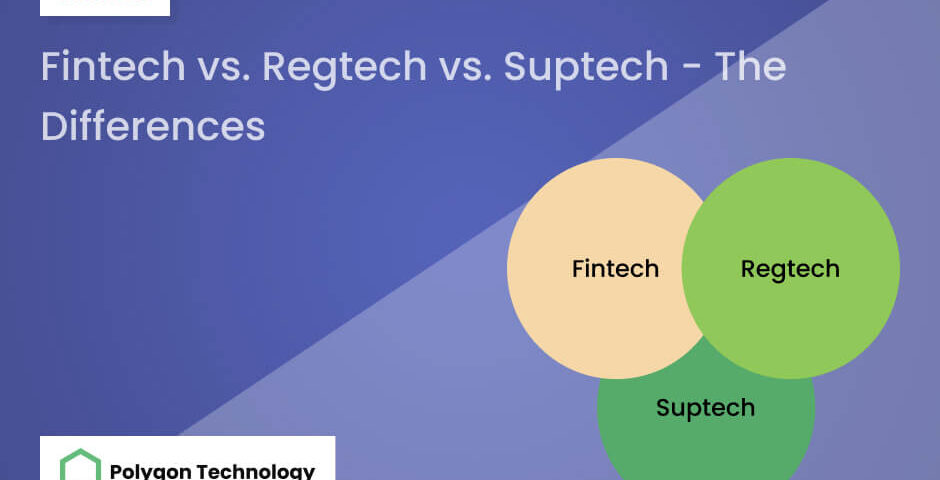
Fintech vs. Regtech vs. Suptech – The Differences
Fintech vs. Regtech vs. Suptech – The Differences

Sadman Sakib Khan
Sadman is a marketing professional and a fervent devotee of the ever-evolving world of marketing & technology. Possessing a knack for crafting compelling narratives, Sadman passionately engages in the creation of top-tier content in close partnership with esteemed subject matter experts.

The financial services and banking industry has seen the rise of three new technologies, which are FinTech, RegTech, and SupTech. The debate between FinTech vs. RegTech vs. SupTech has become a major concern for users and business owners. These kinds of financial solutions are linked with each other via various similarities. However, they also have some differences.
To help you differentiate them and know how to utilize them effectively, we will check out their differences and similarities. FinTech, SupTech, and RegTech are all integral parts of a complete risk and compliance program, each offering unique advantages and uses. In this article, we’ll delve into the differences among all these technologies and how they influence the financial industry.
Introduction to FinTech
Financial technology, or “FinTech,” means any hardware or software that helps provide, maintain, and improve financial services. Its goal is to simplify complicated financial procedures, making them more user-friendly and simpler for the risk and compliance team to handle. FinTech solutions can serve consumers, businesses, or both.
With a combination of B2C and B2B use cases, these solutions can vary in the services they offer and the specific areas they focus on. By providing straightforward online services, FinTech strives to provide innovative technology that transforms how clients interact with financial organizations.
FinTech directly competes with traditional banking and changes the perspectives of people in both sectors. Thanks to this shift in the banking landscape, consumers can access financial services more efficiently and rapidly.
When Should You Use FinTech?
FinTech simplifies risk management for businesses and everyone involved in the financial ecosystem. It helps them avoid problems like natural disasters, equipment breakdowns, cyberattacks, and data breaches. FinTech software can monitor business activities in real time, make predictions based on data, and keep track of operational and financial performance to assist decision-making.
These solutions are great for automating financial services for companies and customers. FinTech solutions assist teams in preventing fraud and handling their AML compliance program more efficiently by making operations smoother and more effective.
Introduction to RegTech
RegTech, also known as “regulatory technology,” involves solutions that handle and improve regulatory operations and procedures. These technological solutions aim to simplify compliance-related processes, improve risk management, and keep the risk and compliance team updated on legislative requirements.
RegTech solutions are developed to assist AML (Anti-Money Laundering) institutions in efficiently monitoring and handling regulatory procedures. There are various types of RegTech solutions available to meet your specific needs. The most effective solutions combine automation and cloud-based technologies with the expertise of regulatory professionals.
With the guidance of regulatory experts, navigating through regulatory complications becomes more straightforward. The best RegTech solutions excel at spotting, recognizing, and analyzing the dependencies between various risk types to enhance efficiency.
When Should You Use RegTech?
RegTech offers support and technical expertise to help teams stay compliant with regulations. For this reason, it’s used by various financial organizations like brokerages, cryptocurrency exchanges, FinTech, credit unions, neobanks, and even traditional banks. Many companies that have operations in multiple places and deal with various regulatory bodies and rules turn to RegTech.
These solutions bring together different regulatory requirements into one system, making it easier for Risk and Compliance teams to manage everything from one single dashboard. Small financial institutions can also benefit from RegTech solutions. It helps them optimize their operations and stay compliant with regulations without needing to expand their Risk and Compliance teams.
Using RegTech solutions is an excellent way to maximize your regulatory compliance efforts and get the most out of your investment. Overall, RegTech solutions offer several advantages, such as preventing fraud, enhancing consumer protection, and preventing money laundering.
Introduction to SupTech
Supervisory technology, known as SupTech, involves software that helps streamline and manage supervisory tasks. Financial institutions need to follow many rules and regulations. At the same time, supervisory agencies must make sure these institutions are following the rules and regulations properly. SupTech provides tools for these supervisory agencies to use automation effectively.
Suptech is also known as “Regtech for supervisors.” Financial institutions use both RegTech and SupTech solutions to make sure they follow the rules. SupTech can quickly alert financial institutions when new fraud methods appear. It can also help find out more about fraudsters’ actions, like how often they conduct fraudulent activities, how much money they make, and other data.
SupTech Solutions has more access to data than other financial organizations, so it can spot fraud better. Once they figure out how to fight this new type of fraud, they can share the best ways to combat it with other businesses that may be at risk of the new dangers.
When Should You Use SupTech?
SupTech revolutionizes how financial authorities handle tasks that used to be slow and tedious. These solutions make data collection easier, analyze data more thoroughly, and make it simpler for teams to access and use information. Teams can now automate tasks that used to require on-site visits and audits, saving time and money.
SupTech streamlines auditing processes with detailed reports and analytics. Also, SupTech solutions can spot signs of new risks in the financial ecosystem, helping financial companies warn the entire Fintech industry about these dangers.
Certain solutions even measure the overall trends in the finance market. This helps regulators understand the finance industry’s current state and assists companies in tackling major challenges.
Fintech vs. Regtech vs. Suptech: The Major Differences
FinTech, SupTech, and RegTech are each distinct from one another, even though they’re related and sometimes seem similar. The similarities among FinTech, SupTech, and RegTech give a good idea of how they can make financial services better. However, it’s important to notice the differences between them based on the following points.
Term Differences
FinTech stands for “financial technology.” It covers any technology used to optimize, deliver, or manage financial services. FinTech is used by both customers and businesses for various purposes. RegTech stands for “regulatory technology.”
It deals with technology used to manage compliance operations within an organization. Businesses use RegTech to regulate their own procedures. SupTech stands for “supervisory technology.” It involves technology used to oversee compliance operations within organizations. Businesses use SupTech to supervise other businesses.
Motives Behind Implementation
In a discussion about FinTech versus RegTech versus SupTech, a key factor for differentiating them is why they’re used. FinTech brings a more personalized way to use financial services, making them easier to access, simpler to use, and more convenient. It also works toward making sure more people have access to financial services, aiming for better financial inclusion.
RegTech’s main goal is to ensure that financial institutions follow the relevant rules and regulations. RegTech solutions help these institutions handle complex regulatory requirements, which can help them avoid penalties and fines.
SupTech is important for revolutionizing financial reporting. It gives supervisory agencies better technological tools to monitor new types of fraud. Also, it helps with assessing risks and data analysis at a systemic level.
Target Audience
FinTech offers a perfect solution for financial service providers, banks, and users to boost financial inclusion and the supply of financial services. Its applications focus on the customer, providing solutions like peer-to-peer lending, mobile banking apps, robo-advisors, and digital payment platforms. FinTech’s solutions aim to enhance the end-user experience directly.
RegTech is a great option for brokerages, neobanks, fintechs, credit unions, crypto exchanges, and banks. Its applications contain tools for automating compliance, platforms that improve data security, and risk management solutions. RegTech’s solutions are created to help financial institutions fulfill regulatory requirements smoothly.
SupTech is suggested for financial authorities tasked with using data to spot new risks in the financial services sector. Its applications contain tools for data analytics, predictive modeling for supervisory objectives, and systems for real-time monitoring. SupTech’s solutions help regulatory authorities keep the financial ecosystem stable and secure.
Unique Benefits
FinTech focuses on bringing in new technologies that could change how consumers interact with financial services. Its main goal is to introduce solutions that make financial transactions easier, faster, and more user-friendly.
RegTech focuses on automating, managing, and improving regulatory compliance tasks for financial institutions. Its main aim is to help businesses handle complex regulations more efficiently.
SupTech offers a unique benefit over the rest by offering a type of RegTech designed for supervisors. It works at a regulatory level, aiming to empower supervisory authorities like regulatory bodies and central banks. SupTech emphasizes offering insights and tools for efficiently monitoring financial institutions.
What Are The Relationships between FinTech, RegTech, and SupTech?
Understanding the relationship between FinTech, RegTech, and SupTech might seem tricky. A great way to understand their relationship is to remember that RegTech and SupTech are two types of technology that cover a wide range of industries, including financial services. On the other hand, FinTech focuses only on technology for financial services. So, when you think of FinTech, think of financial services.
This means that in the world of financial services, RegTech and SupTech are two types of FinTech solutions. Similarly, FinTech tools that handle supervisory or regulatory tasks fall under SupTech and RegTech. As financial services face strict rules and monitoring, both SupTech and RegTech solutions fit well in the FinTech world.
That is why they’re generally used by FinTech companies such as crypto exchanges and neobanks. They work hand in hand. FinTech solutions keep expanding what financial services can do, while RegTech makes sure these solutions follow the required regulatory rules.
From the date they were created, FinTech, RegTech, and SupTech have always worked together, and it looks like they will for many years to come.
Final Thoughts
The detailed comparison of FinTech vs. RegTech vs. SupTech shows that they all use innovation and technology to enhance financial services. Fintech focuses on improving how financial and banking institutions serve their customers. It ensures that these institutions can provide their services to consumers more effectively.
RegTech focuses on tackling the challenges of new regulatory requirements in the evolving financial industry. SupTech serves as a strong technology for supervisory authorities to ensure financial institutions comply with relevant rules and regulations.
As we navigate these three types of technologies, we see how FinTech prioritizes user needs, RegTech ensures compliance, and SupTech strengthens regulatory oversight.